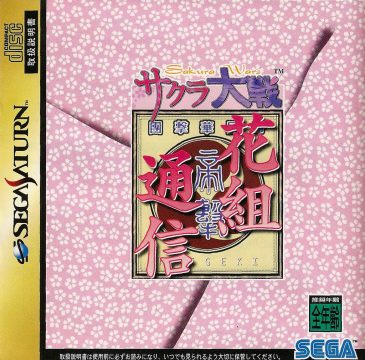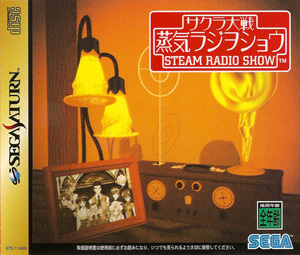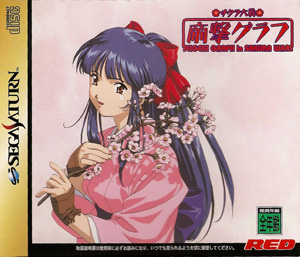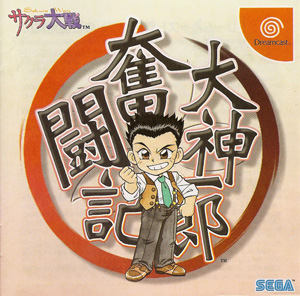Sakura Taisen Hanagumi Tsuushin (サクラ大戦花組通信) – Sega Saturn (1997)
The first of many fan discs, this was released in February of 1997, less than half a year after the first game. Its title means “Flower Troupe News”, reflecting its theme as a sort of update on what is going on in the Sakura Taisen world — in an era before the Web was commonplace. The disc is laid out as a newsletter, which you can flip through, zoom in and read, and click to view scenes. For example, click the story about the Sakura Taisen radio program, and Sakura reads out the airtimes for each region of Japan — quaint to encounter 15 years later. You can play through a little quiz which determines which Flower Troupe member suits you best, culminating in a date scene. There are also tiny, short clips of greetings from the voice actresses.
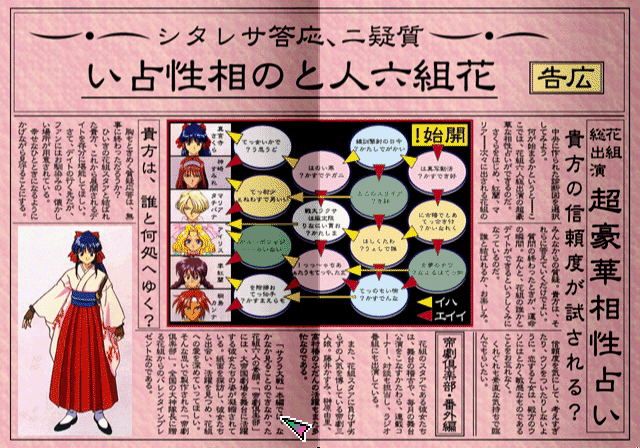
Character compatibility fortune-telling.
The art assets are nearly all either recycled from Sakura Taisen, or are live-action photographs or videos of the cast and staff – this product was clearly made in a hurry and on the cheap. In all, this sort of disc serves the same purpose that an official website would today, except not nearly as well, and for the price of an entire game. For a fan, though, it is a charming little artifact and a sort of game-culture time-capsule. You can almost feel the Sakura Taisen mania sweeping Japan, and Sega scrambling to satisfy fans’ demands for more Hanagumi.
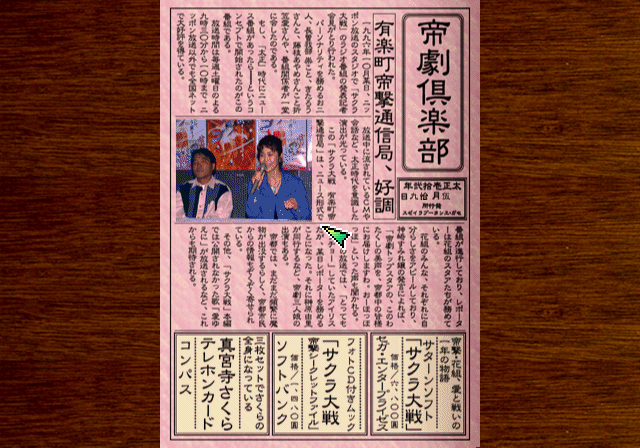
The main UI is a newsletter.
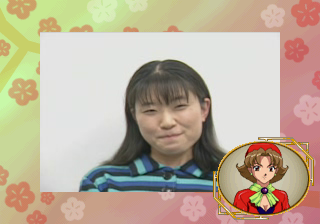
A message from Yuki Masuda (CV Yuri).
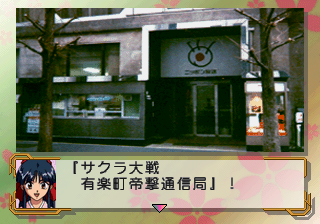
“Sakura Taisen Yūrakuchō Teigeki News”.
Sakura Taisen Steam Radio Show (サクラ大戦蒸気ラジヲショウ) – Sega Saturn (1997)
The second fan disc to come out after the initial game, this time in November of 1997. It’s a much more substantial offering than Hanagumi Tsuushin, featuring actual new art assets and gameplay. It is presented as two distinct sub-products in one package, each on its own disc and each with its own manual.
Disc one is the “Play Disc” (using the character for a vinyl record), and contains several scenarios to play through, centered around the theme of a radio show being put on by the Imperial Revue. You can choose the heroine you want to be the DJ, and enjoy vignettes of her talking, responding to fan mail, and so on. Interspersed with this are new heroine-themed mini-games, similar to the ones in Sakura Taisen proper. The radio-show storylines lead into the “Feeling Couple” mode, which of course culminates in a date. There’s also a bit of preview promo information for the hotly anticipated Sakura Taisen 2, just six months away.
Disc two is the “Musical Disc”, and presents a digest version of the first Sakura Taisen stage show, Ai yueni (愛ゆえに), “Love, therefore”. In addition to the play, there are interviews with the voice-actors-turned-stage-actors. Of course, the video is of that characteristic tiny and grainy Sega Saturnquality, from a time when any video at all seemed like a miracle. Finally, there is a catalog of sorts, detailing the various Sakura Taisen goods available that you ought to spend all of your hard-earned money on.
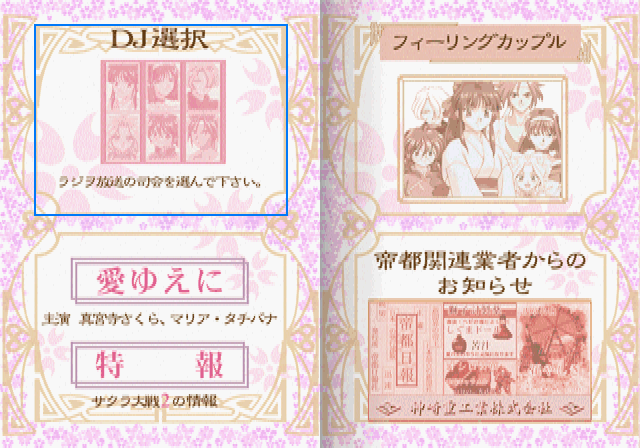
The many modes of Steam Radio Show.
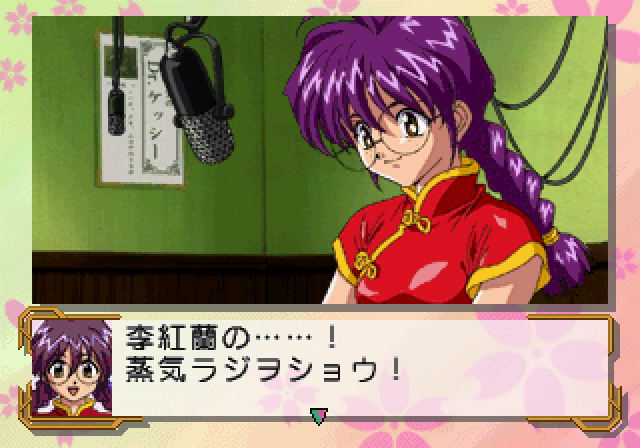
Kōran is your host for today.
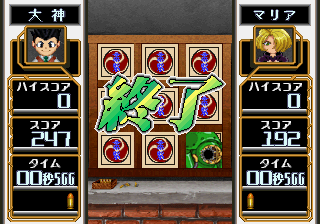
Maria’s shooting minigame.
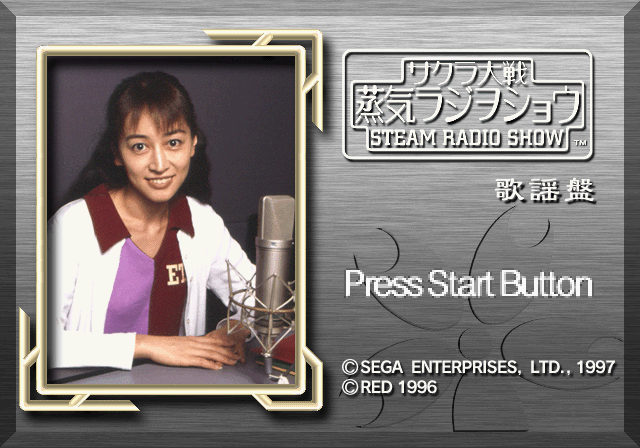
Chise Yokoyama (CV Sakura) welcomes you to disc 2.
Sakura Taisen Teigeki Graph (サクラ大戦帝撃グラフ) – Sega Saturn (1998)
As Hanagumi Tsūshin and Steam Radio Show were companions to the first Sakura Taisen, Teigeki Graph is to Sakura Taisen 2. It was released in December of 1998, almost nine months after ST2. Disc 1 offers an adventure scenario to play through, centered around a production of Sleeping Beauty. Showing a stronger investment of time and resources, this scenario actually includes minigames for each heroine, like the mainline Sakura Taisen titles. It also contains a Sakura Taisen glossary and an art gallery.
Disc 2 is full of more low-quality Sega Saturn video files. It is divided into sections for PR videos (TV commercials and such) and a section of cast interviews. The cast interviews feature an entertaining gimmick: each one actually has a LIPS dialog in it, allowing you to prompt the interviewee to talk about a topic of your choice.
Ultimately, the extra scenario is the most compelling bit of this product; it and the scenarios on the other fan discs are worth including in a playthrough of the Sakura Taisen series.
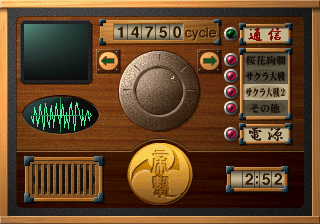
The Kinematron is your interface.
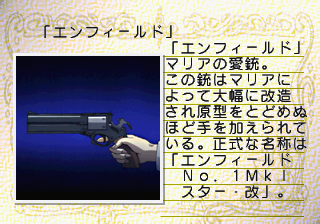
Sakura Taisen universe encyclopedia.
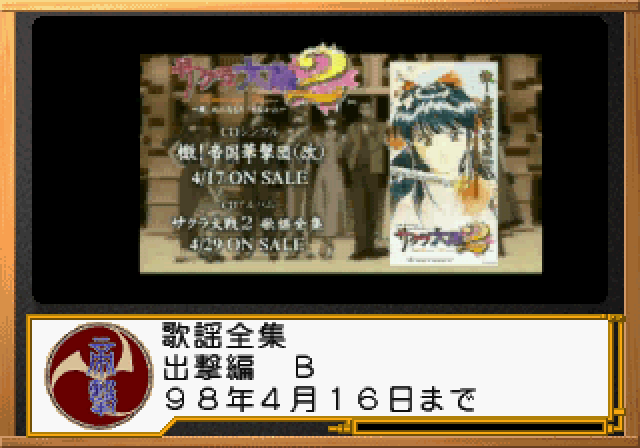
Commercials in that marvelous video quality.
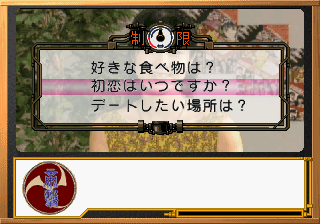
Interviewing Ai Orikasa (CV Kaede) via LIPS.
Ōgami Ichirō Funtōki (大神一郎奮闘記) – Dreamcast (2000)
This game is surprisingly awesome, if only because of how bizarrely meta it is. It was released in February of 2000, and by that time the Sakura Taisen stage shows had become pretty elaborate affairs. The voice cast had transmogrified themselves into a stage cast, performing ever more self-intertwined stories in which they appeared on stage as their characters preparing to put on a play, and then portrayed their characters portraying characters in the play. This, then, is a video game about the putting on of a stage performance with characters who are portrayed by characters who are from a video game about actors who put on stage performances. It is as awesomely self-referential and surreal as it sounds.
It may make more sense to take it chronologically. Sakura Taisen is a series of video games about robot pilots who also perform stage plays. In real life, the voice actors began putting on stage plays in which they portray the robot pilots preparing and putting on stage plays. One of these stage plays was then made into a video game, combining video clips from the real-life performance with regular video game segments as if they are all part of one continuity.
Most of the game is an ordinary Sakura Taisen adventure-part scenario, interspersed with video clips from a real-life performance by the Sakura Taisen voice cast of the original play Benitokage (紅蜥蜴), “Crimson Lizard”. After each clip, you get to deal with the behind-the-scenes view of what is going on around the theater, which leads into the next clip. This is a fun thing to get wrapped up in; the clips are actually surprisingly entertaining and well-integrated into the storyline.
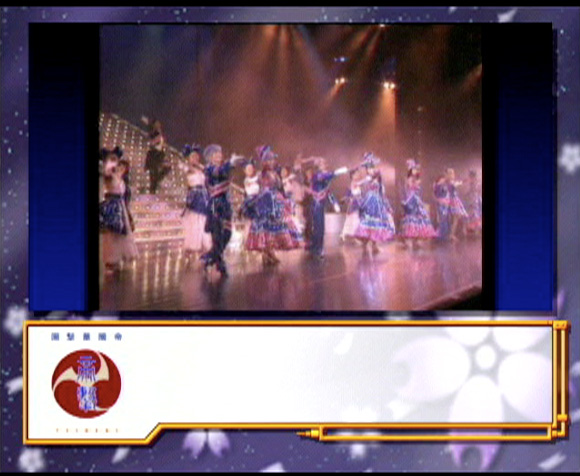
The big opening dance number.
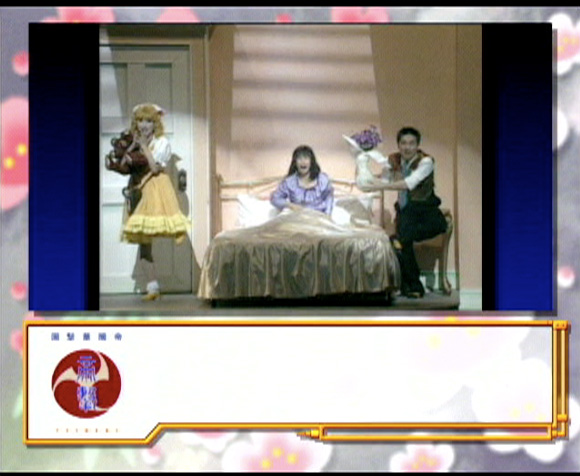
Hijinks in Sumire’s room.
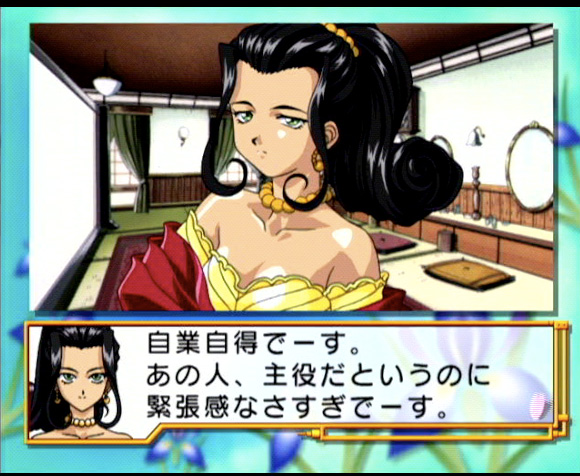
Orihime in an adventure part…
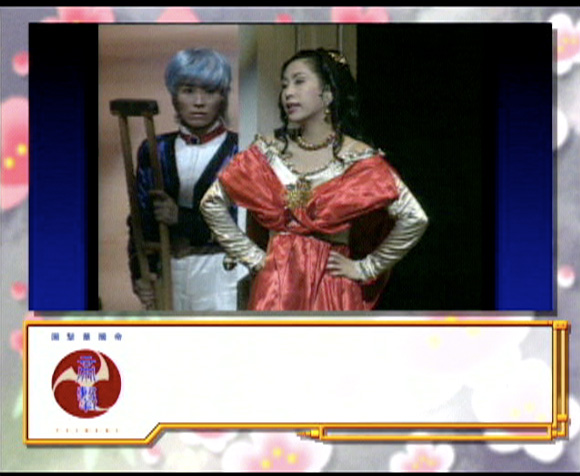
…And just moments later in a live-action part.
Sakura Taisen Online (サクラ大戦オンライン) – Dreamcast (2001)
Continuing with the Internet-enabled trend, this Dreamcast game was released in two editions in December of 2001. It comprises a series of tabletop games and minigames that can be played online against others, or offline against Sakura Taisen characters. This all takes place in Sakura Town, a somewhat absurd amalgamation of Tokyo and Paris; the edition you buy determines on which side you can set up your personal room. Each player gets a customizable avatar and a room to decorate, using items bought with in-game currency. The tabletop games include hanafuda, daifugou, poker, and mahjong. The limited edition of the game came with a full Dreamcast keyboard, in Sakura Taisen pink, of course.
Sakura Taisen Kinematron Hanagumi Mail (サクラ大戦キネマトロン 花組メール) – Dreamcast (2000)
Released for Dreamcast in December of 2000, when anything Internet-related was thought to be extremely desirable. As such, it is one of the many bits of online-specific game console software that is useless nowadays. It was also included with the special-edition pink Sakura Taisen Dreamcast hardware. The purpose of this disc was to compose emails with themed stamps and stationery, as is popular for geeky Japanese folks, especially around the new year. These could then be sent to other people… who owned the same disc. Messages sent to people using normal email accounts would show up as ordinary text. Combine that specificity of audience with the intentionally-obtuse Kinematron interface, and you have a pretty dumb product.
Screenshots were taken from the Sesega blog.
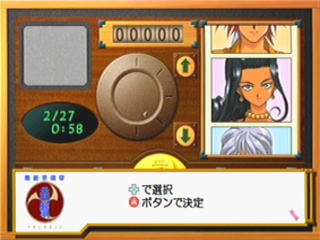
Combat scene in mid-attack.
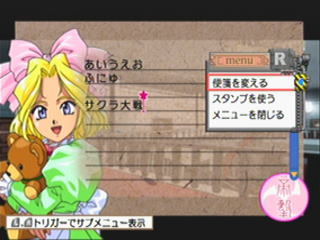
Leveling up after battle.
Sakura Taisen Monogatari: Mysterious Paris (サクラ大戦物語 ~ミステリアス巴里~) – PS2 (2004)
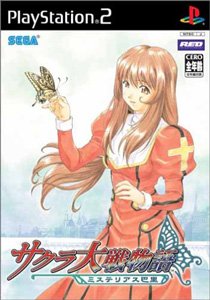
Cover
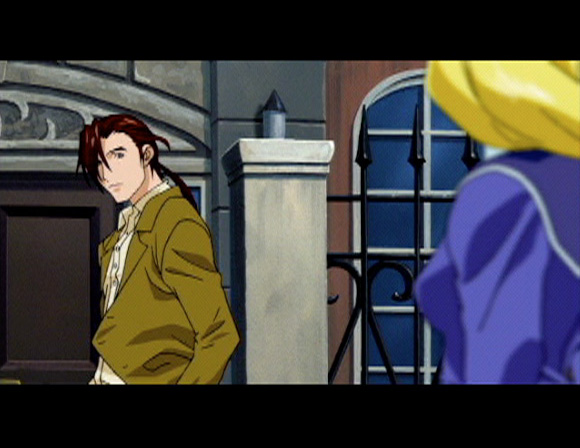
Anime sequence.
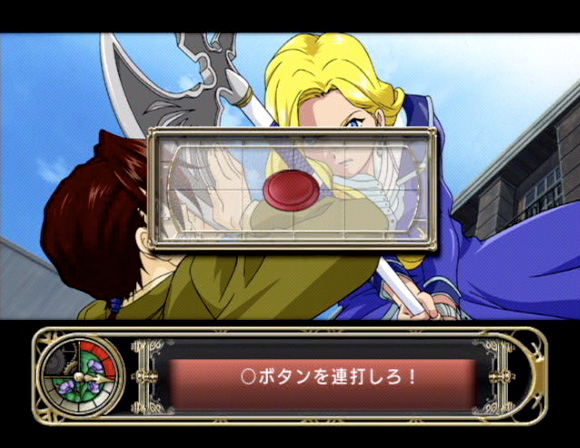
Rapid button pressing challenge.
Now here is an odd game. Originally announced as part of the Sakura Taisen World Project in 2002, along with the rest of the products that were supposed to carry the franchise to great global success, it was finally released in March of 2004. Sakura Taisen Monogatari was meant to be a gaiden (side-story) series, using the settings and characters of the main series, but with different protagonists. Initially, a Tokyo counterpart was meant to be developed alongside this Paris installment, but that game never materialized.
Mysterious Paris takes place after the events of Sakura Taisen 4, and follows the adventures of detective Kojirou Akechi and his sister, Chattes Noires performer Miki Akechi – both are playable characters. The story focuses on a series of mysterious disappearances of Chattes Noires performers, and much of the game plays out in LIPS-based adventure scenarios. The game does introduce a few innovations, such as a life bar (enough bad choices can eventually deplete it and get you a Game Over screen), first-person dungeon crawling, and rudimentary shooting events. It’s surprisingly well put-together, considering its peripheral status, with full-on anime sequences and good production values. But it is a bit odd to be running around locations from Sakura Taisen 3, and interacting with its cast of heroines and NPCs, with Ohgami and the Kōbu nowhere to be found.
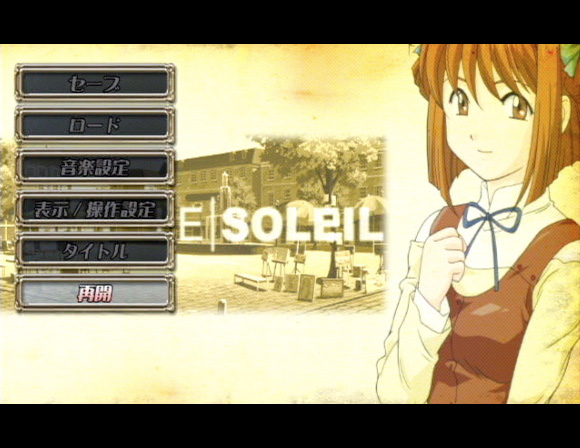
Eyecatch.
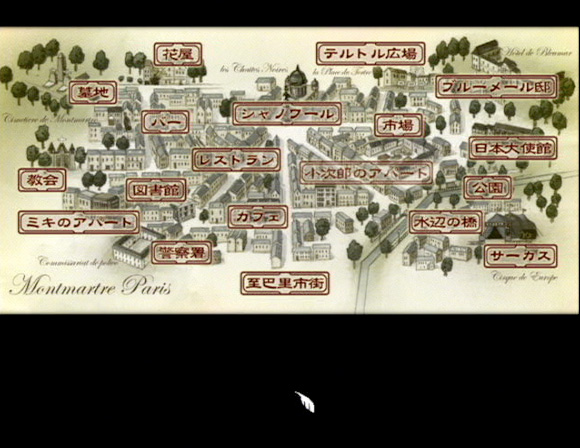
The map offers lots of locations around Paris.
